The Setting
With the beloved King Karl Franz III, deathly ill, the tiny kingdom of Unkerlant was already on edge when news arrived that Borogravian troops were massing at the southern border. The small village of Grenzburg was the obvious target. Grenzburg was no longer legally part of Unkerlant, being annexed in the last war a generation ago, but most Unkerlanters still considered it part of the realm.
With the monarch on his deathbed, the defense of the kingdom’s honor fell to his sister, the Arch-Duchess Bruhilde of Volborg. Orders to march to the defense of Grenzburg quickly went out, though not from the duchess herself, but from her consort Augustus (a man despised as much as Brunhilde is loved). Troops quickly moved south and in the early morning a few days later, the battle began.
Forces were remarkably equal. Both sides had 5 regiments of dragoons and 3 of cuirassiers, 6 regiments of regular infantry and 4 of grenadiers and guards, including on the Volborg side, the Duchess’s Own Elite Grenadier Guards. Four batteries of artillery.
The armies arrayed in a mirror of each other. Dragoons faced dragoons, the guard the guard and so on down the line. The commanders too were both men of equal ability, good by the standards of Unkerlant, poor by the rest of the world.
Commanding the forces of the Grand Duchy of Volborg would be the Duchess Consort himself, Augustus. The Borogravians were led by the exiled Prince Ruprect.
Volborg began the battle, marching forward boldly, full of love for their duchess and pride in their arms. Volborg would hold the initiative for most of the battle, but was plagued by indecisiveness. On the far left, General Baron Von Bombast sent his cuirassiers into a narrow pass between two woods, in hope of forcing his opposite into fighting him on a narrower front. On the right, the mad General Biblenburg sent his massed dragoons up the hill to his front. The center left and right marched steadily forward. General Reddentropp seemed unsure how to deploy the grenadiers in the center left, and spent a lot of the battle milling about.
Across the battlefield the whole Borogravian line trundled forth, except for General Mathias on the right. It seems his gout had acted up again, and he was having trouble mounting his horse. Thus, the Borogravian heavy cavalry sat.
When the cuirassiers finally moved, they were forced to meet their rivals in between the woods, just like Von Bombast planned. The two met, and grueling fight of attrition began. The same was true on the opposite end of the line. Volborgian dragoons charged and charged again. After three attacks and counter attacks, the Borogravians under General Moorstadt finally broke. One regiment managed to break through the other side, later to threaten the Volborgian rear and baggage.
Meanwhile, Borogravian infantry under General Reezburk captured Grenzburg.
This was an acceptable setback to the Volborgians as they thought they would soon be driving them out.
In the middle, General Reddentropp’s indecision was about to cost the Volborgian the left flank. The bloody cavalry battle between the woods was on and both sides were locked in combat. While the Volborgian grenadiers sat on the hill and watched, their opposite number moved in behind the pinned cuirassiers. Now stuck between the heavies in front and the grenadiers behind, they were destroyed. Their whole left flank was open.
The center had become a large infantry slugfest with no clear winner emerging.
This was the scene when night fell. Both sides were equally bloddied, but Borogravia held the town. Retaking it proved too much for Augustus. Grenzburg would remain a foreign possession.
Aftermath
I think everybody thought the rules worked great, except for one instance where a lone cav unit was holding up several infantry units, with them unable to engage the cav. All attempts at whittling them down with musketry failed.
The forces were completely balanced and so were the losses.
I created some printed blanks to playtest and this inspired me to get back to painting.

























































No comments:
Post a Comment